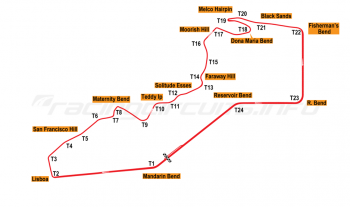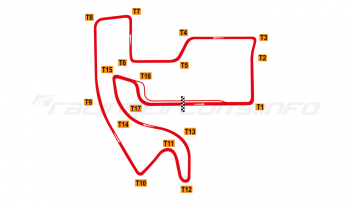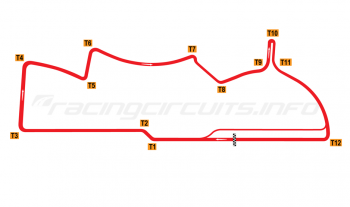Reims
Circuit Overview
Perhaps the most famous of the traditional European road circuits - and certainly among the fastest - the Reims circuit was located near to the village of Gueux in the Champagne region of France.
The essentially triangular circuit was laid out on ordinary country roads, including the flat out blast of the RN31, which provided a straight to rival the Mulsanne at Le Mans.
Run by the flamboyant Raymond 'Toto' Roche for the Automobile Club de Champagne, Reims enjoyed great slipstreaming battles on the track, and the support of enthusiastic organisers off it. Unusually for a temporary road course, the circuit boasted proper pit facilities and grandstands opposite.
While the course held its last race in 1972, the pit facilities and grandstands remain in place, now partially restored thanks to the efforts of local enthusiasts.
Circuit History
Motor racing first took place in the Marne district of the Champagne region in 1912 and 1913, when motorcycle races were organised on a 225 km / 140 miles road course, near to the town of Sarcy. Located around 20km west-south-west of Reims, the course was known as the Circuit de la Champagne.
It wasn't until 1925 that the first race for cars was held, on the 20km Circuit Beine-Nauroy, which was located 10km south east of Reims near to the Reims-Prunay airport. The Grand Prix de la Marne moved the following year to the shorter road circuit laid out to the west of Reims, linking the villages of Thillois and Gueux in a roughly triangular circuit.
The majority of the course ran through open countryside, save for the opening section which darted through the outskirts of the village, between houses and shops. The start/finish area was located around a mile outside of the village of Gueux, on the minor D27 road which largely only served as a route to the village itself.
Featuring some reasonable elevation changes on the long blast along RN31, the circuit was characterised by long stretched of flat out straights, linked by slow hairpin turns. Measuring 4.857 miles (7.816 km), it immediately became one of the fastest circuits on the racing calendar.
The event was an instant success and by 1932, the popularity of the race prompted the French Automobile Club to use the circuit as the host of the French Grand Prix. In preparation, the track widths were slightly improved at the Garenne-Gueux / Thillois corners, leading to a new published length of 4.863 miles (7.826 km). Tazio Nuvolari raced to victory in an Alfa Romeo P3.
Other races established at what was known as the Reims-Gueux circuit included a 12 hour sportscar race, held for the first time in 1927, and regular bike meetings.
In 1938 further changes prior to the Grand Prix de France saw the Thillois-Gueux straight receive extensive widening. Many trees were reportedly felled and various trackside structures demolished to improve safety and increase speeds. A new timing hut, the Pavillion Andre Lambert, was installed just before the pit buildings. This time it was the German Silver Arrows cars which dominated, with Manfred von Brauchitsch taking the victory for Mercedes-Benz. The following year's race saw Auto-Union get their revenge, with Hermann Paul Müller taking the spoils.
The intervention of war stopped all activity until 1947, when Swiss racer Christian Kautz won the Grand Prix de Reims in a Maserati 4CL. Prince Bira took victory in a Simica-Gordini 11 in the accompanying Coupes des Petites Cylindrées. The following year saw the Grand Prix de France return to Reims, run to Formula One rules for the first time, albeit as a non-championship race. The Alfa Romeo of Jean-Pierre Wimille took the win, with speeds continuing to rise.
By 1952, race organisers had decided to bypass the village of Gueux, building a new link road to connect the start/finish straight with the Virage de la Hovette. This was the first stage of an extended, permanent section of road for racing only.
The second part of the extension was made in 1953, up to a new hairpin bend leading onto RN31, while the last major modifications came before the 1954 season, when both then Muizon hairpin and the Thillois corners were re-profiled and made much faster. This then created the final, classic layout of the Reims circuit, which saw the track rise to prominence as France's premier circuit through the 1960s.
Reims witnessed some epic slipstreaming races. It also played host to an international 12-hour sportscar race at the French Grand Prix meetings, alongside many national categories.
The last F1 race was in 1966 (won by Jack Brabham), with sportscars continuing until the following year and Formula 2 until 1969. Motorcycle races then formed the mainstay for the next three years.
Competition from other circuits and financial and political difficulties finally closed the track in 1972. The grandstands and decaying pit garages still remain by the roadside as a poignant reminder to the speed aces of the past.
Les Amis du Circuit de Gueux (a non-profit organisation) is working to preserve the old pit building, grandstands and other remaining structures of the circuit, with the aim of actively supporting the resumption of historic meetings on the 1952 version of the circuit.
Jump onboard
Circuit info
This is a historic circuit which is no longer in operation.
Rate This Circuit
Votes: 1665
Location Information
The Circuit de Reims is located on the D26 road from Reims to Gueux in the Champagne region of France.
Since the circuit’s closure, there have been numerous changes to the local road infrastructure, though much of the basic public road remains, as do the former grandstands and pit buildings.
Upgrading of the RN31 to dual carriageway carried out in the early 2004 means that the former straight between Muizon and Thillois is now much wider, though it follows the original course, though Thillois is now a large roundabout. It is still possible to drive a lap around the (more or less) original 1926 version through the centre of Gueux and the 1952 variant of the circuit, except for the old Garenne junction, which was demolished as part of the RN31 modernisation.
It is no longer possible to complete a lap of the circuit used from 1953 onwards as the tarmac between Bretelle Nord and Muizon has been removed and ends in an open field. Alongside the road in that stretch is a small monument to pioneering Franco-Austrian racer Annie Bousquet who died in a crash on the approach to Muizon in 1956 12 Hours race.
Get your race tickets!
Brought to you with: 
We've teamed up with Motorsports Tickets to bring you the best deals for Formula One, MotoGP, Le Mans and more.











